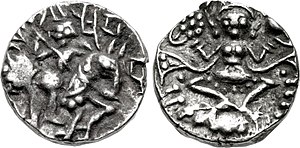Harsha of Kashmir
| Harsha | |
|---|---|

Coin of Harsha of Kashmir (1089-1101 CE).
|
|
| Maharaja of Kashmir | |
| Reign | 1089-1111 AD |
| Predecessor | Maharaja Ajitdeva |
| Successor | Kushaladitya IV |
| Born | 1001 AD Kashmir |
| Died | 1189 AD Kashmir |
| Spouse | Kusal Rani Vartakar Rani |
| Issue | Adesheva Maharani Ajirani |
| House | Lohara dynasty |
| Father | Maharaja Kalasha |
| Mother | Eshant Maharani |
| Religion | Hindu |
Harsha, also Harshadeva, (ruled 1089-1111 AD) was a king of Kashmir. Harsha belonged to the Utpala dynasty, of which he was the last ruler. According to Kalhana, Harsha was built like a god and was extremely handsome. Harsha's conduct has recently been a subject of discussion. Harsha started out as a capable and noble king, then ran into financial trouble because of his spending habits. He was the son of king Kalasha of Kashmir
Kalhana's Rajatarangini gives an interesting account of Harsha. Note that Kalhana's father Champaka was a minister of Harsha. Kalhana wrote during the time of Jayasimha (AD 1127-59).
He destroyed both Hindu and Buddhist temples, and is credited with creating an office of "devotpaatana-nayaka", destroyer of gods. In Kalhana's time, Buddhism was flourishing in Kashmir, and was not considered a distinct religion from "Hinduism". He refers to Buddhists' idols just like Brahmnaical ones. Kalhana was very familiar with Buddhism, and mentions Buddhist concepts accurately. Buddhism appears to have survived in Kashmir for a long time. It has been suggested that somewhere at Baramulla a Buddhist monk was present until the 14th century. Abul-Fazl, author of Ain-e-Akabari was able to locate Buddhists in Kashmir.
From Taranaga (chapter) VII of Rajatarangini (Stein's translation):
It has been suggested that he had been influenced by Turushkas:
Here Kalhana appears be to stating that Harsha did not even follow the religion of the people he was favoring. He however does call Harsha "that Turushka":
The statue at Parihaspura was built by Lalitaditya Muktapida.
Abul-fazl mentions that the temples of Parihasapura were finally destroyed by Sikandar Butshikan "Butshikast" (1389–1413).
There was a great fire in Srinagar during the reign of Sussala. All the buildings were burnt except the colossal Buddha:
That reminds one of the Great Buddha of Kamakura, the wooden temple of which was destroyed by a tidal wave. The temple of the Great Buddha of Nara was similarly destroyed by fire, but was later rebuilt. a colossal copper image of Buddha once stood in Nalanda, said by Xuanzang to have been 80 feet (24.6 m) tall. The great Buddhas of Kashmir may have been similar.
...
Wikipedia
